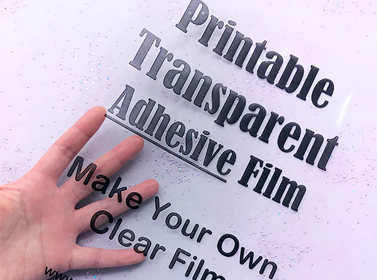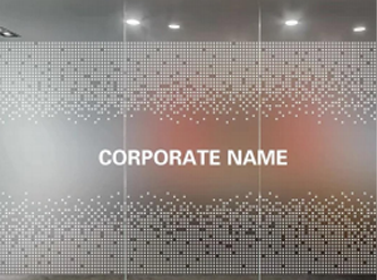How to Extend the Outdoor Lifespan of Permanent Adhesive Film: A Complete Guide
What is Permanent Adhesive Film?
Permanent Adhesive Vinyl is a pressure-sensitive adhesive film made of polymer materials, which has strong adhesion and excellent weather resistance. Its back is coated with a permanent pressure-sensitive adhesive layer, which can be firmly attached to the substrate surface with light pressure, and can be installed without additional heating or special equipment.
Table of Contents
ToggleUnlike removable films, permanent adhesive films are difficult to completely remove without damaging the substrate once applied, making them more suitable for scenarios that require long-term display and fixation effects.
Key Factors Affecting Outdoor Lifespan
1. Material Quality
The quality of the film material is the primary factor determining its lifespan.
- Base film material: High quality PVC or PET base film not only has better ductility and tear resistance, but also maintains excellent dimensional stability and is not easily shrunk or deformed.
- Surface coating: A film with an anti ultraviolet (UV) protective coating that can effectively resist strong sunlight and prevent fading, powdering, or cracking due to UV decomposition.
- Adhesive formula: Using high-quality pressure-sensitive adhesive, it can ensure viscosity in different temperature and humidity environments without premature failure. In contrast, inferior film often loses adhesion, bubbles, or discolors within a few months.
2. Climate and Weather Conditions
The complexity of the outdoor environment directly affects the durability performance of the film:

- UV irradiation: Strong and long-term exposure to sunlight is the main cause of film aging, especially in tropical or high-temperature areas, where the film may fade faster and lose its flexibility.
- Rainwater and humidity: Continuous humidity may weaken the durability of the adhesive. If the waterproof performance of the film is insufficient, it is easy to cause edge water seepage and adhesive layer peeling.
- Temperature difference variation: The temperature difference between day and night or seasonal alternation of hot and cold can cause the film material to repeatedly expand and contract, resulting in problems such as cracking, wrinkling, or edge warping.
3. Surface Treatment and Construction Technology
Good installation techniques are crucial for extending the lifespan of film:
- Surface cleaning: If there is residual dust, grease, or moisture on the surface of the substrate, it will significantly affect the adhesion, leading to bubbles and detachment.
- Construction environment: Construction in environments that are too cold or too hot can affect the bonding between the film and the substrate. It is recommended to install in an environment of 15-30 ℃.
- Tools and methods: Using professional scrapers and heating tools can avoid bubbles and wrinkles, ensuring a tight fit between the film and the substrate.
4. Film Protection
Adding a layer of transparent film (such as cold mounting film or hot mounting film) on the surface of the film can significantly improve its weather resistance:
- UV resistance: Reduce the damage of UV rays to printing colors and base films.
- Waterproof and scratch resistant: forms an additional protective layer, effectively resisting physical damage such as rainwater, dust, sand and gravel.
- Extended lifespan: After lamination, the outdoor service life of the film can be extended by 1-3 years, especially suitable for long-term display of advertisements and car body stickers.
Permanent Adhesive Film vs Removable Film
| Comparing Dimensions | Permanent Backing Film | Removable Film |
| Adhesive Strength | The adhesive on the back is strong and long-lasting, with stable adhesion and is not easy to peel off | The backing adhesive is relatively gentle, easy to remove, and leaves no obvious residue |
| Applicable Period | Suitable for long-term use, outdoor lifespan can reach 3-7 years | Suitable for short-term promotion or temporary decoration, usually 3-12 months |
| Remove Difficulty | During removal, there may be residual adhesive marks and even damage to the substrate | Easy to remove, almost without damaging the substrate |
| Common Applications | Outdoor billboards, vehicle body film, long-term brand display | Window display promotion advertisements, exhibition display boards, short-term event promotions |
| Cost Input | Usually higher than removable models, but with a longer lifespan | Low cost, suitable for short-term advertising budgets |
| Weather Resistant | Waterproof, UV resistant, high temperature resistant, suitable for harsh outdoor environments | Weak weather resistance, mostly used for indoor or short-term outdoor environments |
Tips for Extending Outdoor Lifespan
1. Choose High-quality, UV Resistant Film Materials
High quality permanent adhesive film is usually made of polymer PVC or cast grade PVC, and added with anti UV additives or surface coatings, which can effectively reduce fading, powdering, and brittleness caused by ultraviolet radiation. In long-term exposure to sunlight, the lifespan of such materials can often be extended by 1-3 years compared to ordinary film. Enterprises should choose products with performance certifications such as UV resistance and Weather proof when purchasing.
2. Ensure that the Surface is Clean, Smooth, and Dry Before Applying the Film
The substrate treatment before construction directly determines whether the film is firm:
Cleaning: Use a mild cleaning agent to remove dust, oil stains, and wax residue.
Drying: Avoid moisture on the construction surface, otherwise it will weaken the adhesion of the glue, leading to foaming or peeling.
Smooth: If there are unevenness or scratches on the surface of the substrate, the film is prone to producing bubbles or wrinkles, which shortens its service life.
Proper pre-treatment can achieve optimal bonding between the film and substrate.

3. Avoid Construction in Extremely Cold or Hot Weather
The recommended installation temperature for the film is usually between 15 ℃ and 30 ℃.
In low temperature environments, the glue will harden, its viscosity will decrease, and it is easy to peel off in a short period of time after installation.
In high temperature environments, membrane materials will experience stress due to excessive stretching, making them more prone to shrinkage and edge formation in the future.
Therefore, it is advisable to choose indoor constant temperature construction or install during suitable weather periods.
4. Use Cold Mounting Film or Hot Mounting Film for Secondary Protection
Adding transparent protective film on the surface of the film is an effective method to improve weather resistance:
UV protection: reduces the damage of sunlight to color and base film;
Waterproof and scratch resistant: Enhance surface strength and reduce damage caused by rainwater, sand and gravel, or cleaning friction;
Extended lifespan: In most cases, film covering can extend outdoor service life by an additional 1-3 years.
For advertisements and car body films that require long-term bright colors, film coating is almost an essential step.
Conclusion
The outdoor lifespan of permanent adhesive film depends on the material quality, climate environment, and construction process. Choosing the appropriate level of film and taking protective measures can keep advertising images or decorative graphics bright, durable, and beautiful even after years of outdoor use.









